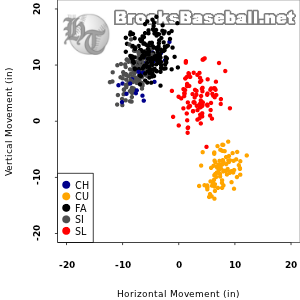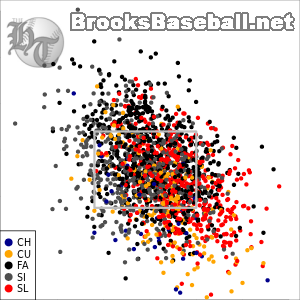PITCHf/x Scouting Report: Jake Arrieta
The Orioles send right handed pitcher to the mound tonight to face and the Yankees. Arrieta was a 5th round draft pick from the Baltimore Orioles back in 2007. By 2009, the 23 year old pitcher played through double-A and triple-A, as well as being ranked the #67 prospect by Baseball America. In 2010, Arrieta dominated triple-A with a 1.85 ERA, 7.9 K/9, and 4.2 BB/9, in 73.0 innings, and was promoted to the major league rotation. Between his 2010 and 2011 season in Baltimore, he’s posted a 4.88 ERA, 5.9 K/9, and 4.4 BB/9, in a disappointing 219.2 innings. He’s seen some improvement in his fastball and statistics this year, so we’ll delve into his career selection, as well as his 2012 velocity and breaks.
Pitch Repertoire
Arrieta has a 5 pitch repertoire. His two fastballs are a 94 mph four-seam and 93 mph sinker, which are coupled with an 87 mph changeup. He also has two breaking pitches, an 87 mph slider, and a 78 mph curveball. His selection in 2012 has been 34% four-seam, 25% sinker, 18% slider, 17% curveball, and 5% changeup.
 The graph above plots Arrieta’s release point in 2012. The zone of release points is fairly typical for a right handed pitcher, falling 1 to 3 feet to the left of the mound, and 5.5 to 7 feet above. The wide range of points, especially with the sinker and slider, indicates that he may have trouble replicating his delivery, perhaps why he struggles with command at points. You can see Arrieta’s 3/4 arm slot in the picture on the right.
The graph above plots Arrieta’s release point in 2012. The zone of release points is fairly typical for a right handed pitcher, falling 1 to 3 feet to the left of the mound, and 5.5 to 7 feet above. The wide range of points, especially with the sinker and slider, indicates that he may have trouble replicating his delivery, perhaps why he struggles with command at points. You can see Arrieta’s 3/4 arm slot in the picture on the right.
The two images above trace the pitch break of his 5 pitches, from the release point on the left to homeplate on the right. The top image shows a bird’s eye view of the horrizontal pitch break. The sinker, four-seam, and changeup all move in on right handed pitchers, with the slider and curveball breaking away. In the bottom image, the vertical break is shown from a 3rd or 1st base view. The four-seam has the least break, with it’s “rising” action, following by the sinker. The slider and changeup have bigger downward break, with the curveball having the most.
Above, we can better understand the break of each pitch by the plotted horizontal and vertical movement from the catcher’s perspective. The four-seam fastball has an above average 6 inch break into same side hitters, as well as a rise of 11 inches above the no-spin origin. The sinker has more movement in on right handed hitters, 10 inches horizontally, and sat 9 inches above the x-axis. The changeup also moves hard into righties at around 8 inches, with slightly more vertical drop than the sinker at 8 inches above the x-axis. The slider moves horizontally 6 inches into left handed hitters, opposite of the other 3 pitches, but lacks the drop of most major league sliders, sitting at 4 inches vertically. His last breaking pitch, the curveball has the most break down, averaging 9 inches below the x-axis, and has tremendous movement into left handed hitters at nearly 12 inches.
Where he Throws It
The graph above plots the different pitch types based on location to right handed hitters. While he’ll often attack the zone with both fastballs, he’s more apt to attack in with the sinker, which moves in, and throws the four-seam above the zone to try and draw pop-ups. His curveball and slider, which have movement down and away, are usually thrown down and away to get hitters chasing. In 2012, his selection to righties has been 27% four-seam, 33% sinker, 29% slider, and 12% curveball.
Against lefties, both his fastballs are located away in the zone. The changeup, which moves down and away, is thrown down and away to get hitters chasing. The slider and curveball are located in the same location, this time down and in to lefties to jam them. In 2012, his selection to lefties has been 38% four-seam, 21% sinker, 12% slider, 20% curveball, and 8% changeup.
When He Throws It
| Count | Four-seam (R) | Sinker (R) | Slider (R) | Curveball (R) | Changeup (R) |
| 3-0 | 88% | 12% | 0% | 0% | 0% |
| 3-1 | 61% | 22% | 11% | 6% | 0% |
| 2-0 | 51% | 35% | 14% | 0% | 0% |
| 2-1 | 34% | 30% | 25% | 6% | 6% |
| 1-0 | 39% | 25% | 26% | 9% | 2% |
| 0-0 | 45% | 18% | 23% | 13% | 1% |
| 1-1 | 22% | 28% | 34% | 11% | 5% |
| 0-1 | 31% | 30% | 27% | 13% | 0% |
| 3-2 | 44% | 24% | 26% | 3% | 3% |
| 2-2 | 26% | 28% | 27% | 12% | 7% |
| 1-2 | 35% | 18% | 29% | 14% | 4% |
| 0-2 | 39% | 18% | 32% | 10% | 1% |
Here we have Arrieta’s selection based on count in his career. Starting a count off to righties, he began throwing the four-seam fastball, and mixed in the sinker, slider, and curveball. As he fell behind in the count, he relies on the four-seam, but also increases his sinker usage to encourage groundball contact. After strike one, his sinker increases along with the slider and curveball. After strike two, he will usually throw a breaking ball at a 40% rate, with his four-seam at slightly less. Facing righties, he has a 12% whiff rate on the slider, his goto out-pitch, and a 14% whiff rate on the changeup.
| Count | Four-seam (L) | Sinker (L) | Slider (L) | Curveball (L) | Changeup(L) |
| 3-0 | 90% | 10% | 0% | 0% | 0% |
| 3-1 | 58% | 36% | 5% | 0% | 0% |
| 2-0 | 51% | 33% | 2% | 0% | 14% |
| 2-1 | 30% | 34% | 8% | 11% | 18% |
| 1-0 | 27% | 34% | 3% | 14% | 22% |
| 0-0 | 36% | 29% | 3% | 24% | 9% |
| 1-1 | 21% | 29% | 8% | 21% | 21% |
| 0-1 | 20% | 29% | 7% | 28% | 17% |
| 3-2 | 27% | 27% | 22% | 11% | 12% |
| 2-2 | 28% | 26% | 20% | 15% | 11% |
| 1-2 | 26% | 11% | 30% | 23% | 10% |
| 0-2 | 49% | 14% | 11% | 20% | 6% |
Arrieta starts lefties off mixing his four-seam, sinker, and curveball. As he falls behind in the count, he again becomes reliant on his four-seam and sinker, particularly the four-seam 3-0. After strike one, the righty substitutes some of his four-seam selection with changeups, and after strike two, he finally breaks out the slider for the strikeout. He’s had less success against lefties in his career, with the slider and curveball each drawing a 10% whiff rate.
Results
As a pitcher that mixes four-seams and two-seams, his batted ball rate is 43% groundballs, 39% flyballs, and 18% linedrives. Over his career, he’s shown a 6.08 K/9 and 4.18 BB/9, but this year those numbers have improved to 7.12 K/9 and 2.67 BB/9. An increase in velocity from 92.3 mph in 2011 to 93.3 this year, may be the reason for his early success. Although he has virtually no home/away split, Arrieta has a terrible platoon split facing lefties, who hold him to a .277/.369/.489 triple slash, compared to righties who only hit .231/.304/.343.
Against The Yankees
In 6 starts against the Yankees, Arrieta has pitched to a 4.25 ERA, 1.33 WHIP, and 7.3 K/9. In 3 starts in the Bronx, he has never given up a homerun, and he’s posted a 3.63 ERA, hampered by a 1.500 WHIP and only a 4.7 K/9. Although Jeter, Granderson, and Teixeira have good numbers off him, the entire Yankees team only has 2 previous homeruns off him, both Grandyslams.
| Probable Yankee Lineup | At Bats | Triple Slash |
| SS | 15 | .400/.471/.600 |
| CF | 16 | .313/.353/.875 |
| 3B | 5 | .200/.444/.400 |
| 2B | 15 | .200/.333/.333 |
| 1B | 16 | .375/.444/.500 |
| DH | 2 | .000/.333/.000 |
| RF | 2 | .000/.333/.000 |
| Eduardo Nunez LF | 2 | 1.000/1.000/1.000 |
| C | 9 | .222/.364/.222 |
Prediction
Arrieta currently has a 4.45 ERA, 4.07 FIP, and a 3.79 xFIP, behind some improved velocity and control. His career numbers aren’t brilliant, but there are some changes to his game that could result in success. Usually, the Yankees would send out seven lefty hitters to topple the right handed hitter, but tonight there will only be five, two of which are Chavez and Ibanez. This lineup is far from what we’re accustomed to, but Arrieta’s career numbers don’t scream shutout.
One Response to PITCHf/x Scouting Report: Jake Arrieta
Leave a Reply Cancel reply
-
LIKE TYA ON FACEBOOK
-
Recent Activity
Recent Posts
- Cervelli’s Value
- Could Nova Be Tipping His Changeup?
- Series Preview: Interleague Play Take 1: Reds visit the Bronx
- Yanks lose 4-1
- May 17 Game Thread
- What’s different about 2012 Kuroda?
- 2012: A Freak Injury Odyssey
- Robbie’s fastball problem
- Morning stroll down memory lane
- Yanks tattooed by Toronto, 8-1
Recent Comments
- bg90027 on Cervelli’s Value
- 5/18-5/20 Series Preview: Cincinnati Reds | River Avenue Blues on Cueto brilliant in 10-2 Reds victory; Gordon unable to Aaron Small himself out of disappointing start
- on Series Preview: Interleague Play Take 1: Reds visit the Bronx
- 5/18-5/20 Series Preview: Cincinnati Reds | River Avenue Blues on Nova spins finest game of career in 5-3 Yankee win over Reds
- bottom line on Yanks lose 4-1
- Phil C on Yanks lose 4-1
- T.O. Chris on Yanks lose 4-1
- on Yanks lose 4-1
- bornwithpinstripes on What’s different about 2012 Kuroda?
- Professor Longnose on May 17 Game Thread
-
Authors
Twitter
* TYA Twitter -
* EJ Fagan -
* Matt Imbrogno -
* William J. -
* Larry Koestler-
* Moshe Mandel -
* Sean P. -
* Eric Schultz -
* Matt Warden -
-
Most poker sites open to US players also provide online casinos accepting USA players. A good example of this is BetOnline.com, where you can play 3D casino games, bet on sports or play poker from anywhere in the United States.
-
Other Links
-
Blogroll
Blogs
- An A-Blog for A-Rod
- Beat of the Bronx
- Bronx Banter
- Bronx Baseball Daily
- Bronx Brains
- Don't Bring in the Lefty
- Fack Youk
- It's About The Money
- iYankees
- Lady Loves Pinstripes
- Lenny's Yankees
- New Stadium Insider
- No Maas
- Pinstripe Alley
- Pinstripe Mystique
- Pinstriped Bible
- River Ave. Blues
- RLYW
- Steven Goldman
- The Captain's Blog
- The Girl Who Loved Andy Pettitte
- The Greedy Pinstripes
- This Purist Bleeds Pinstripes
- Value Over Replacement Grit
- WasWatching
- Yankee Source
- Yankeeist
- Yankees Blog | ESPN New York
- Yankees Fans Unite
- YFSF
- You Can't Predict Baseball
- Zell's Pinstripe Blog
Writers
- Bats (NYT)
- Blogging the Bombers (Feinsand)
- Bombers Beat
- Buster Olney
- E-Boland
- Jack Curry
- Joe Posnanski
- Joel Sherman
- Jon Heyman
- Keith Law
- Ken Davidoff
- Ken Rosenthal
- LoHud Yankees Blog
- Marc Carig
- Tim Marchman
- Tom Verducci
Resources
- Baseball Analysts
- Baseball Musings
- Baseball Prospectus
- Baseball Think Factory
- Baseball-Intellect
- Baseball-Reference
- BBTF Baseball Primer
- Beyond the Box Score
- Brooks Baseball
- Cot's Baseball Contracts
- ESPN's MLB Stats & Info Blog
- ESPN's SweetSpot Blog
- FanGraphs
- Joe Lefkowitz's PitchFX Tool
- Minor League Ball
- MLB Trade Rumors
- NYMag.com's Sports Section
- TexasLeaguers.com
- THE BOOK
- The Hardball Times
- The Official Site of The New York Yankees
- The Wall Street Journal's Daily Fix Sports Blog
- YESNetwork.com
-
Site Organization
Categories
Tags
A.J. Burnett ALCS Alex Rodriguez Andy Pettitte Baltimore Orioles Bartolo Colon Boston Red Sox Brett Gardner Brian Cashman Bullpen CC Sabathia Chien-Ming Wang Cliff Lee Curtis Granderson David Robertson Dellin Betances Derek Jeter Francisco Cervelli Freddy Garcia Game Recap Ivan Nova Javier Vazquez Jesus Montero Joba Chamberlain Joe Girardi Johnny Damon Jorge Posada Manny Banuelos Mariano Rivera Mark Teixeira Melky Cabrera Michael Pineda Minnesota Twins New York New York Yankees Nick Johnson Nick Swisher Phil Hughes Prospects Red Sox Robinson Cano Russell Martin Statistical analysis Tampa Bay Rays Yankees -
Site Stats










Fantastic analysis. Deserves a comment, even though I don’t have much to say. One small note: I would use plate appearances instead of at bats in the final table.